Linnea G. Skoglund, Plant Disease Diagnostician,
Montana State University, Bozeman, MT 59717
(linnea.skoglund@montana.edu)
and
Tamla Blunt, Plant Disease Diagnostician,
Colorado State University, Fort Collins, CO 80523
(tamla.blunt@colostate.edu)
Skoglund, L. G., and Blunt, T. 2012. The plant diagnostic lab experience. APS Features. doi:10.1094/APSFeature-2012-05.
Plant diagnostics has been called an art and a science. The art of diagnosis is a system of rules or governing principles and implies a trained ability or mastery of science (2). A good diagnostician is a generalist with a broad scientific knowledge in subjects such as botany, plant physiology, plant anatomy, soil science, cropping systems, horticulture, greenhouse/nursery management, pesticides, and, of course, plant pathology and entomology. Successful diagnosticians are keen observers and good communicators. A successful diagnostician must also be part detective, collecting all facts related to the problem in order to reach the proper identification and provide appropriate control measures. In this age of specialization, the diagnostician often is the person in her/his department with the broadest, most eclectic knowledge. Besides being well-versed in the basic sciences, today’s diagnostician needs information technology skills. Increasingly, social media (Facebook, blogs, websites, Twitter, etc.) are becoming information dissemination tools to reach multiple audiences as well as ways to inform the public of the plant diagnostic laboratory’s existence.
Technical expertise in pathogen identification has gained importance in recent years. Every clinic is either equipped with, or has access to, sophisticated equipment for molecular analysis (Fig. 1). Today’s diagnosticians also have access to multiple training opportunities to improve their molecular skills as well as refreshing basic diagnostic skills. The cost of molecular identification has decreased to the point where it is almost as inexpensive as an ELISA test, making this a feasible option for identifying specific pathogens.
| |
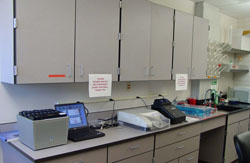
Fig. 1. Most clinics are equipped for molecular analysis of plant pathogens. Photo by T. Blunt. |
|
Rapid and accurate diagnosis of plant health problems is essential to maintaining healthy landscapes, forests, farms, public spaces – everywhere plants are found. Plant diagnostic laboratories, what we call "plant clinics," provide identification of diseases, insects, weeds, and environmental issues that threaten the green world around us. They are integral parts of state land grant universities, usually in association with Extension. The earliest reported clinic was established at the Connecticut Experiment Station in 1888 (3). However, most came into existence in the mid-20th century at the same time that the role of Extension and Extension plant pathologists was being redefined. Clinics were established to: (i) provide rapid and reliable diagnoses; (ii) train graduate students and extension agents; (iii) record and maintain data on pest occurrence; (iv) detect and track new and invasive pests; and (v) facilitate responses to the clients they serve. Most plant clinics support extension, research, teaching, and regulatory programs at the state and federal level.
Centralized, publicly supported clinics now exist in 48 of the 50 states and offer a range of services from general diagnosis with visual observation, culturing of pathogens, and ELISA tests for virus identification to the latest molecular techniques. Thirty-two clinics integrate a combination of pathology, entomology, or plant identification in one lab (see NPDN plant clinic directory). Clinic activities may also include statewide survey work, phytosanitary certification services, fungicide-sensitivity testing, mycotoxin analysis, limited soil testing, endophyte testing, testing seed for internal or external pathogens, and other testing services based on regional or local needs. Many of these activities require special expertise or training.
Every clinic is different in day-to-day operations. One of the greatest differences is how they are staffed. Most are overseen by a faculty member (usually an extension specialist) in a plant pathology department, but similarities cease there. Staff might be full time, part time, or graduate students. There may be only one or several people that work in the plant clinic depending on the size of the clinic and the overall operational structure. Personnel might be core funded, grant funded, or subsidized with fees, workshops, and other revenue-generating activities. Some diagnosticians may also teach in their respective departments as part of their appointment.
Trends noted by Aycock in 1976 (1) are just as true today in 2012: (i) increasing numbers of ornamental plants from urban dwellers; (ii) more awareness by agents of disease damage; (iii) increasing numbers of specimens; and a greater percentage of difficult-to-diagnose specimens, with (iv) a concomitant decrease in easily diagnosable diseases.
The diagnostic process begins with observation of the signs and symptoms on the sample along with studying the background information (Fig. 2). Microscopy and culturing continue to be the mainstays of diagnostic procedures (Fig. 3). Serological methods (especially "dipstick" tests) are widely available and relatively inexpensive, making them a staple in clinics. Molecular techniques are utilized routinely in a few clinics. The bane of the existence of all diagnosticians is the poor sample and lack of information. Every gathering of diagnosticians will include conversations about the most outrageous sample received. Autopsy season starts after crops are harvested. A favorite line – "It just didn’t do as well as I expected." The most difficult part of being a diagnostician is training the clientele to bring or send a representative sample of the problem to the plant clinic when symptoms are first noted rather than waiting until the plant has died. A review of the diagnostic process previously appeared at APSnet's The Plant Health Instructor (4).
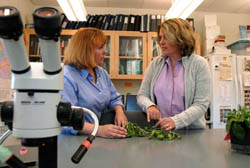 |
|
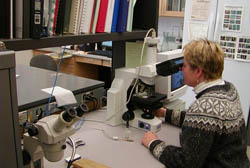 |
|
Fig. 2. Diagnosticians discussing signs and symptoms on a sample. Photo by L. Skoglund. |
|
Fig. 3. Microscopes are the mainstay of the plant clinic. Photo by L. Skoglund. |
Diagnosticians across the United States are also at the forefront of plant biosecurity. Plant clinics are important in identifying new and invasive pests submitted by homeowners, growers, extension agents, and others. Diagnosticians may also be included in ipmPIPE programs as cooperators with research pathologists to evaluate plant material for various surveys that are conducted through these programs.
Working with producers and state and federal regulatory agencies to protect export markets is an important role of many diagnostic clinics. In Montana, monitoring diseases in the field through the samples received and surveys helps to protect the $100 million wheat industry, the $4 million cherry industry, and the alfalfa seed industry worth $5.4 million. The lab (in conjunction with the state seed lab) tests 300+ seed samples of chickpea, pea, and lentil for Ascochyta, an important seed borne pathogen (Fig. 4). In other states, it may be corn, potatoes, or soybeans that are routinely monitored for pathogens.
|
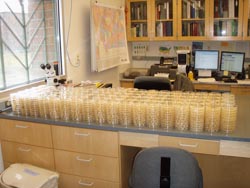
Fig. 4. Plant clinics often participate in special projects and testing. Here hundreds of cultures for Ascochyta blight of pea, chickpea, and lentil incubate. Photo by L. Skoglund. |
|
Education is an important part of our role in the university. This can take the form of formal, structured classes for undergraduate or graduate students, or a diagnostician can act as the laboratory coordinator for formal classes. Many departments of plant pathology teach a graduate class in disease and diagnosis that involves the diagnostician. Training may be one-on-one as students assist in the clinic as paid or unpaid interns (Fig. 5). In this instance, the clinic can be an underutilized resource, which is really unfortunate. The plant clinic is generally designed to be used in a teaching capacity, be it for students or even extension agents.
|
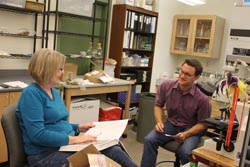
Fig. 5. Working one-on-one with graduate student is an important step in training the next generation of diagnosticians. Photo by L. Skoglund. |
|
Many diagnosticians are in some way connected with Extension. As a result we are engaged in adult education in many forms. These typically include master gardener training (both advanced and basic), pesticide safety education, and Extension programming, e.g. presentations to grower/commodity groups and county agents. Extension programming is also becoming regionalized as diagnosticians may be asked to present programs to master gardeners or grower/commodity groups in neighboring states. Other educational activities include media appearances (such as Montana Ag Live, a weekly, hour-long, question-and-answer program on local PBS in the spring and fall) (Fig. 6), local farmers’ markets (Fig. 7), and electronic communication – e-newsletters, pest alerts, blogs, and websites.
 |
|
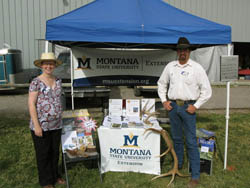 |
|
Fig. 6. Montana Ag Live, a weekly locally-produced TV program, features subject specialists to answer phoned-in questions and diagnose plant problems. It reaches 20,000 viewers per episode. Photo by L. Skoglund. |
|
Fig. 7. Information booths at farmers’ markets staffed by diagnosticians provide a valuable service to the community. Photo by L. Skoglund. |
The Rotten Tuber Award is given by the National Plant Diagnostic Network to the most interesting, unusual, or outrageous sample or phone call received in a plant clinic. What follows are two of the stories submitted in 2011.
Sample 1:
I got a phone call on March 9th this year from a very nice middle-aged man with a peculiar request. He did warn me at the start of our long conversation that his question involved ants and that it "might sound kind of weird."
This guy called regarding a dying pet ant and her "coworker." He had kept an ant farm all winter, and had become close personal friends with these two particular ants that always guarded the nest entrance. He named them, and evidently spent hours a day with them. He talked at some length about their divergent personalities, one a spunky go-getter and the other tending toward false bravado and cowardly retreats. The reason for his call was that "Gigi" (his favorite) had been attacked in the eyes by snails (!?!). To his anguish she was dying before his eyes as we spoke, "suffering hideously". She was blind, and her legs were broken. He wondered if I knew how Gigi might be saved from her injuries. He also wanted a recommendation for an ant-safe pesticide to kill the snails and save "Coverdiver," Gigi’s friend. The caller was a quirky person, but he was very pleasant to talk to, and he knew quite a lot about ants (and has read all of E. O. Wilson’s books, and had even had one autographed by the author when Wilson last visited town).
I wanted to recommend that he take Gigi to a vet, but I didn’t want to sound sarcastic because the guy was so genuinely nice. So I gathered my thoughts, and I gave him some IPM-friendly recommendations. First I told him to pick the snails out of the container. Of course he had tried that already but "snail eggs permeated the soil" (which I guess could be true). So I recommended giving the ants a new home in soil that he first sterilized in the oven. He was only lukewarm about that idea, but of course nothing could really cheer him up on that dark day.
– Ruth O’Neill, Montana State University
Sample 2:
The sample was submitted to the plant clinic for identification. This particular sample was found hiding at the edge of the road just slightly in the ditch. It was kicked loose by a person out walking, then in a moment of remorse it was replanted and saved. The walker felt that it had continued to grow even after being dislodged from the soil. It was identified as Ballicus rubercus. It is spread by dogs and small children. Infestations can be found in toy boxes across the state and large infestations have been found in your local Wal-Mart. Probably wouldn’t cause a major infestation at this time.
|
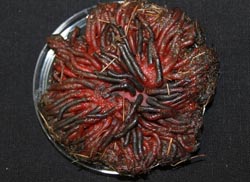
Fig. 8. All clinics receive strange and bizarre samples as illustrated by this one received at the SDSU clinic. Photo courtesy C. Tande, SDSU. |
|
Actually, it was a well-weathered spaghetti ball. And it was a serious sample submission. Yes, we actually gave it a scientific name.
– Connie Tande, South Dakota State University
Plant disease diagnostics is a fun, interesting, challenging, and important discipline. It certainly is not for everyone. Every graduate student should be encouraged to spend time in the clinic. This is how most diagnosticians found their way to the plant clinic. It is through such exposure that we hope to attract future generations of diagnosticians.
1. Aycock, R. 1976. The plant disease clinic: A thorn in the flesh, or a challenging responsibility. Annu. Rev. Phytopathol. 14:165-175.
2. Dictionary.com. 2012. Art (definition). Online. Collins English Dictionary, Complete & Unabridged, 10th Edn. Dictionary.com LLC, Oakland, CA.
3. Evans-Ruhl, G. 1982. Plant disease clinics: Past, present, and future. Plant Dis. 66:80-86.
4. Riley, M. B., Williamson, M. R., and Maloy, O. 2002. Plant disease diagnosis. Online. The Plant Health Instructor. The American Phytopathological Society. DOI:10.1094/PHI-I-2002-1021-01.
Colorado State University Plant Diagnostic Clinic
Montana State University Schutter Diagnostic Lab
National Plant Diagnostic Network
Great Plains Diagnostic Network
CSU Plant Diagnostic Clinic's blog
